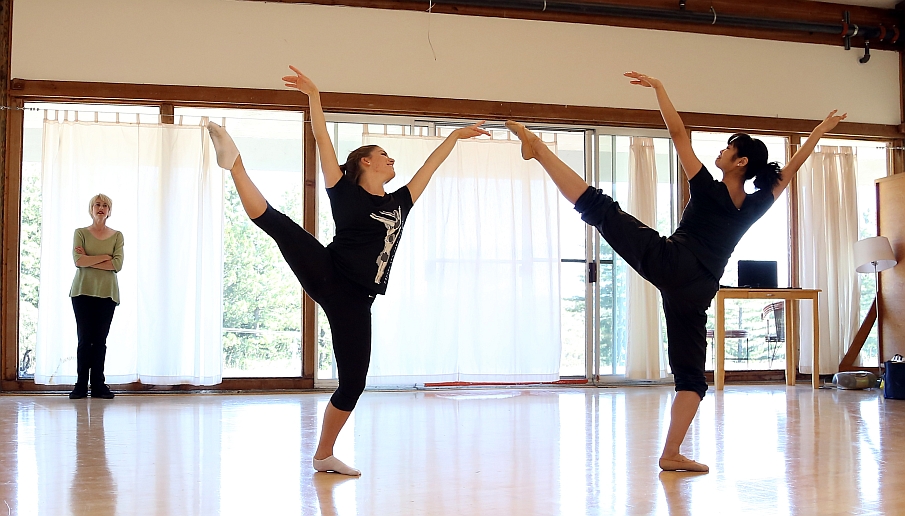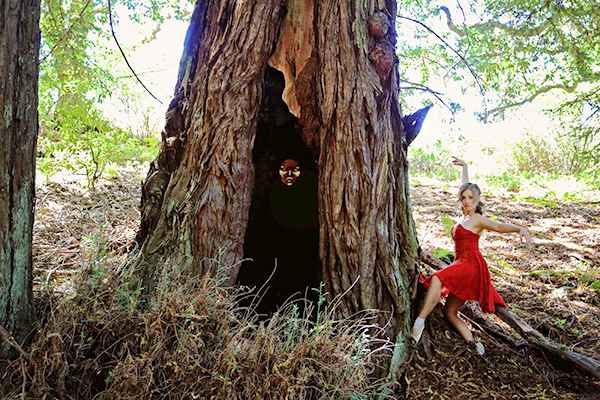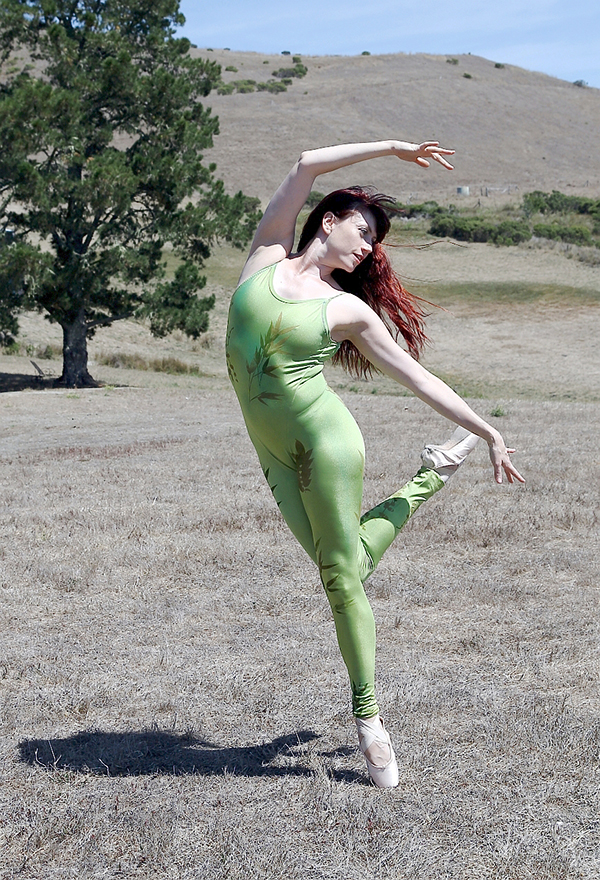Who Gets to Have a Voice?
An Interview with Kathryn Roszak
BY EMMALY WIEDERHOLT
Kathryn Roszak is a ballet choreographer based in the Bay Area. This past year, she spearheaded the inaugural women ballet choreographers residency through the Djerassi Resident Artists Program. She shared with me her perspective on the trials women in ballet face in the pursuit of choreography.
Kathryn Roszak observes rehearsal (Photo by Bari Lee)
~~
As a young dancer, what was your ultimate goal? Did it extend beyond performing?
I would say my goal was expression. Many people gravitate toward dance because they want to be like athletes. They are attracted to the gymnastic physical prowess of it. I gravitated to dance for the theater of it, the expression.
Early on, choreography was also a goal. I was putting on whole ballets in the living room. But when I was training at the San Francisco Ballet School, choreography was not encouraged, so I postponed choreographing for a long time.
I think a large part of why girls don’t gravitate toward choreography is partly because it would be a distraction from the technical perfection demanded from a female ballet dancer. This is a big dilemma, because when men end up being a principal dancer, they often go on to think about choreography.
That addresses my next question: did it seem like your male colleagues were more encouraged to have aspirations beyond performance careers?
I don’t know if they were more encouraged to be choreographers, but they were more encouraged in general. There were fewer of them and they moved up the levels quickly. Most of them could count on having a professional career. It was uncertain whether female ballet dancers would have that opportunity. There was always a perilous feeling for girls that we were going to fall by the wayside and not make it. If you got injured or didn’t get moved to the next level, your future was uncertain, and there was a lot of competition.
You also have to realize that in ballet, women have to perform excellently on pointe, so that’s a whole other aspect of technique that most men are exempt from. Yes, they have to master partnering and special jumps, but women have to master partnering and certain steps as well. And there’s the sense for women that there are a thousand dancers who could replace them; that’s just not true for men. In big ballet companies, they try to make both men and women feel replaceable, but if you’re a man, just look around.
Do you believe the reasons why men routinely hold positions in power in the dance world are coincidental or endemic?
Absolutely endemic. Though when I host panels on the topic, some women will maintain there’s no problem and they never experience a glass ceiling or discrimination. But I feel that, in general, we’re not supposed to focus on inequities or problems, but success. People tend not to emphasize these inequities if they’ve experienced them because they sound like sour grapes; it’s still very much a world where men hold positions of power and, if you want to move up in that world, you don’t want to rock the boat too much. You want to navigate it, so you can’t reject the world if you want to be accepted and work within it.
One of the reasons why we have the Djerassi Resident Artists Program for women ballet choreographers is because hopefully, since it’s not happening under the umbrella of a big ballet company but independently, we can have conversations where women can be more open about their goals and fears.
In Europe, Akram Khan made a statement along the lines of that we shouldn’t have women choreographers just for the sake of having women choreographers; talented women will rise to the top. There was a huge outcry about this. Khan’s statement is an attitude encountered a lot in the world at large, in the dance world, and particularly in the ballet world. But talent isn’t what opens doors. What opens doors are connections and perceptions. Essentially what happens is that if a man says he wants to choreograph, it’s taken much more seriously than if a woman says she wants to choreograph. It’s harder for women to even bring it up. And then if they get the chance to choreograph, it’s often not for the mainstage, but for something on the side.
Talent is very subjective. There are a lot of women out there who are choreographing, but most of them are working for smaller companies or managing their own companies. When you look at where there is money, the women choreographers are not there. Women are usually involved in much smaller ventures. One woman involved in the Djerassi Resident Artists Program said she’s been working for over a decade and still hasn’t been commissioned to do a full-length ballet anywhere. That would not be the case with a male ballet choreographer who’s worked equally long. There’s a real difference in opportunities. Some people believe talent is opportunity and can only be made or given with opportunity. And if you don’t have the opportunity to develop as a choreographer, you’re only going to go so far.
Brennan Wall of New Ballet School, San Jose (Dalia Rawson, Executive Director) participating in Women Ballet Choreographer’s Residency at Djerassi, Woodside. Ca. (Photo by Bari Lee; Sculpture by Derek Jackson 2002)
I also think men are allowed to take more risks and fail. It doesn’t have as big of an impact on their careers. A man who is establishing himself as a choreographer – and we’ve all seen it – might be hit or miss. Sometimes they’re wonderful, other times not, and their careers can ride it. But if a woman is less than excellent even once, she goes down. I can’t name names in this interview, but I’ve seen it. These are the things that can’t always be talked about.
There aren’t a lot of statistics about women in ballet leadership either. When I was writing about it, the last survey I could find was from over a decade ago. The survey I was using, “Who Has the Power in Dance?”, was from 2002, and I believe was done by Dance USA.
There are rarely images of women in positions of power either. When Julie Kent was on the cover of Dance Magazine after being named artistic director of Washington Ballet, she was portrayed as beautiful and ethereal, not as powerful. It’s subliminal.
Sometimes companies will present a celebration of women, but it will only be for one festival or program, and often it’s men doing the picking. Why are women legitimized because men picked them?
What might help more female dancers become interested in directing and choreographing?
We have to have examples. There are women who spend their entire careers as dancers and never work with a female choreographer. It’s similar with Misty Copeland at American Ballet Theater; if you never see African American dancers, it might not occur to you to aspire toward that. We need to see examples on a leadership level.
It’s good that there are more improvisation and choreography classes in dance schools now, but I’m concerned when women don’t move forward with opportunities. Giving opportunities alone is not enough; it has to be combined with examples. If you are a talented ballet dancer and you work with women choreographers, you might think, “When I’m done dancing, I’m going to choreograph.” It takes a special individual to not need an example. I think the women who are choreographing ballets today are just that, and they need more support than ever, both monetarily and in terms of opportunity. You need to have the ability to experiment and grow with your dancers.
I feel as a woman that I can never fail. The degree of excellence has to be so high. I think every woman feels that way; even Hillary Clinton must feel that way. You have to speak, look and behave a certain way to even get your foot in the door.
Another thing that might lure more women into choreography are statistics on pay. I want to know that I will be paid the same as a man for my work. I want to have the same opportunities to grow, develop, succeed, fail, and get paid as men have. Why should that be a ridiculous dream in this day and age?
I couldn’t even encourage my daughter to go into dance because, despite being populated by women, I think it’s a horrible field for women to pursue. They’re not making any money, and they’re fighting for opportunities. Or, even more frightening, they’re not fighting for opportunities because they don’t even think to ask for them.
Any other thoughts?
When I’m interviewed on this topic, there’s part of me that wishes I was a principal dancer at a major ballet company, because I know how much more weight my words would carry. I want that woman to come forward and speak. I want to know there’s a principal dancer who wants to go on to choreograph and will come forward and speak about this issue. I’m speaking about it, but I will only be heard by so many because of the pedigree inherent in the ballet world. It goes back to who gets to have a voice.
Kathryn Roszak’s Danse Lumiere presents the inaugural Women Ballet Choreographers Residency at Djerassi Resident Artists Program (Pictured: Hannah Varga, Photo by Bari Lee)
~~
Kathryn Roszak trained at the San Francisco Ballet and the School of American Ballet, and performed with the San Francisco Opera Ballet. Her company, Danse Lumiere, has collaborated with Kabuki master Shozo Sato, choreographer Alonzo King, musicians Mazatl Galindo of Mexico and Ailu Gaup of Norway, composer Gordon Getty, writers Gary Snyder and Maxine Hong Kingston, and Swedish Nobelist Tomas Tranströmer. Her choreography has been presented by Cal Performances, Scandinavia House, the 92nd Street Y, The Smithsonian Institute, Frank Lloyd Wright’s Taliesin West, the Copenhagen Cultural Festival, and next year she is invited to represent North America in “5 Women, 5 Continents” in Dijon, France. She is invited to participate in “Moving Forward: Women Ballet Choreographers East and West” at the 92nd Street Y in New York City in April 2016, and she will reconvene the Women Ballet Choreographers Residency next May 6th and 7th at Djerassi, Woodside, Ca. She is also producing a new dance film: www.dlkdance.com.



